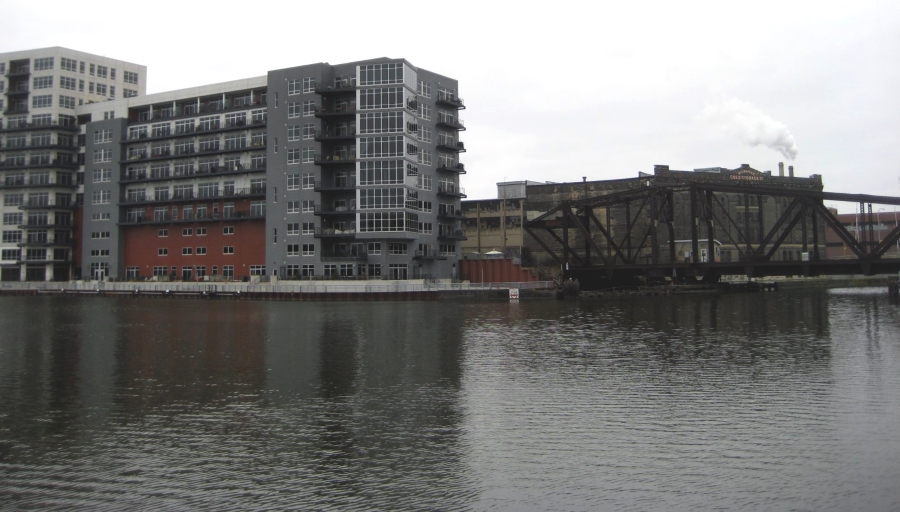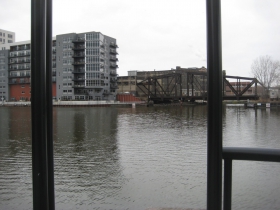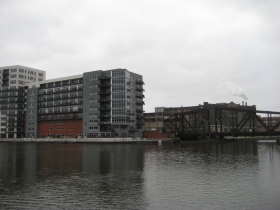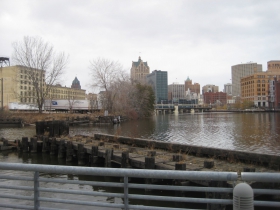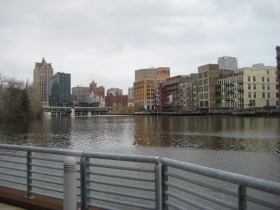Architect Chuck Engberg’s First Place on the River
His condo offers unmatched views of the passing pleasure craft, coal barges and trains.
At the end of the 19th century, the most important commercial intersection in the City of Milwaukee was not on land. Instead it was here, where the Milwaukee Road rail tracks crossed over the Menomonee River just before the stream flowed into the Milwaukee River.
Here, the bulk of the region’s economic products and human traffic passed at one time or another, whether borne by rail or ship. To the immediate west, the massive Reed Street yards spawned dozens of warehouses and factories, while the shores of the rivers teemed with similar structures.
Some, like this building, now known as The Point on the River, had access to both modalities of transportation, enhancing their economic value in what was becoming a manufacturing metropolis.
In 1910, the Canada Atlantic Transit Company had a warehouse and storage shed on this property. In 1917, the Yahr-Lange Drug Co. was located on this spot. It included a 25,000 gallon water tank at dockside. On June 30, 1917, a surge of water flowing down the Menomonee River spun around the whaleback steamer Christopher Columbus; her prow sliced through two of the four legs supporting the tower. In addition to the damage to the ship from the collision, the tank’s contents flooded the ship. Sixteen people were killed in the accident.
By the beginning of this century, the Historic Third Ward had finally built up a critical mass, and developers began to take a chance on the land to the south — Harbor View and Walkers Point — which was still a moribund industrial zone.
At first developers were discouraged by the busy freight and passenger rail tracks alongside the developable properties, but Mayor John Norquist said: nonsense, people like trains. Sure enough, folks do.
A developer named Andy Busalacchi bought the 4-story Terminal Storage building hoping to turn it into a development called the Downtown Yacht Club. Busalacchi cleaned up the property, and did interior demolition of the building, and made a good profit selling it in 2004 to developer Scott Fergus, a former Democratic legislator from Racine. Fergus had great ambitions, including the development of the 601 Lofts building on the Lower East Side and a proposed Racine marina project. He called this project “First Place on the River,” added eight stories to the structure, along with parking and other amenities, and commenced selling units through his Key Bridge Group firm.
Among the first units to be sold, eight years ago this month, is the one occupied by this week’s House Confidential honorees, retired architect Charles M. “Chuck” Engberg and his wife Johanna Susan “Sue” Engberg, an acclaimed writer of short stories.
Chuck Engberg is the founder, with Keith Anderson, of Engberg Anderson Design Partners, a local architecture firm they established in 1988. During the period he was active with the firm (Engberg retired in 2012) the firm was responsible for such significant projects as the 1998 Midwest Express Convention Center (now the Wisconsin Center) and the ongoing 2008 renovation of Milwaukee’s City Hall.
Susan Engberg is the author of four short story collections. Her first, Pastorale, was called “so good that [it] could change your life” by highly regarded author Russell Banks in the New York Times. Certainly she appears to have changed her husband’s life.
The Engbergs paid $589,000 for their 1,722 square foot, 2-bedroom, 2-bath condominium in 2006. As one of the first purchasers, they had their pick of the 154 units in the converted warehouse, and they chose a beauty on the northern end of the first floor. A view from the living room looks straight north across the confluence of the Milwaukee and Menomonee rivers and the railroad swing bridge that constituted the 19th century commercial crossroads of the region. The Engbergs can sit on their landscaped patio watching trains, pleasure craft and coal barges passing by. For an architect with a “long commitment to historic preservation,” his captain’s view of the changing fabric of the city must be a delight. As as sometime jazz musician, the tempo of the city, visible from his windows, must be a creative inspiration to Chuck Engberg as well.
The Engbergs used recycled wood, purchased from the late Pieter Godfrey, in the floors of the unit, but otherwise the couple’s decor tends toward the contemporary, if an Eames lounge chair and ottoman visible through a sliding glass door is any indication.
It was the city’s first large scale condominium calamity of the economic recession. Attorney Michael Polsky, for whom the real estate collapse was good business, was appointed the receiver in 2008, and a judge approved his plan to spend $18.2 million to finish the building and to hire the Mandel Group to handle the condominium sales and Garrison Partners to work on the marketing.
Mandel and Garrison used many novel techniques to drum up interest in the property, including changing the name from First Place on the River to Point on the River; holding parties, seminars and events in the unsold units; and making effective use of electronic and social media for one of the first times in the city’s history to sell real estate.
By 2010 Mandel, assisted by the marketing efforts of the Garrison Partners, was able to report that only 67 units remained unsold. Today only a scattering of mostly small units remain in the original inventory, and resales have been robust.
But the Engbergs’ assessed valuation is far from being that of their $589,000 purchase price. Today the unit is valued at $12,800 for the couple’s .75569% of the development’s land value and $377,200 for the improvements, for a total assessed valuation of $390,000. Taxes of $11,860.73 are paid in full.
Fun Fact: The Engberg condominium sits just a hundred feet or so from the confluence of the Menomonee and Milwaukee rivers. All Milwaukee addresses — East, West, North and South — originate from that point.
The Rundown
- Location: City of Milwaukee
- Neighborhood: Harbor View
- Subdivision: Point on the River Condominium
- Year Built: 1920’s; extensive addition and reconstruction 2006-08
- Style: Eight stories of steel construction above original ferro-concrete warehouse
- Size of unit: 1,277 square feet
- Fireplaces: None.
- Taxes: $11,860.73 Paid in Full
- Assessment: Land $12,800, Improvements $377,200; Total: $390,000.
- Walk Score: 84 out of 100. “Very Walkable”
- Transit Score:55 out of 100. “Good Transit”
- Street Smart Walk Score: 84 out of 100 “Very Walkable”
How Milwaukee Is It? The residence is about .75 miles from Milwaukee City Hall.
Photo Gallery
House Confidential Database
| Name | City | Assessment | Walk Score | Year |
|---|---|---|---|---|
| Name | City | Assessment | Walk Score | Year |


